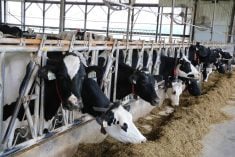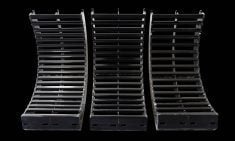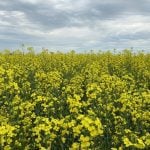HARVEST The wheat is mostly in the bin; here’s how harvest shook out for the crop across the Prairies See story pg 6
The theme for this year’s wheat harvest in the eastern Prairies is “variable,” and not just when experts discuss the big picture in their respective provinces.
Sask Wheat chair Brett Halstead and Manitoba Crop Alliance cereal agronomist Andrew Hector both noted wild yield swings even within the same growing region.
“I’ve heard first- and second-hand about crops from a writeoff — under five bushels per the acre — as far as spring wheat goes, all the way up to 90 bushels to the acre,” Halstead said, although he noted that in his home area of Nokomis southeast of Saskatoon, they’re “pleasantly surprised that the crop is average to slightly better than average.”
Read Also

Finally getting paid for sustainable farming?
Alberta project says they might have a line on a workable ecosystem credit model to reward farmers for sustainability, and Manitoba might be next
Why it matters: Western Canada has had a far from ideal growing season. Now growers, buyers and the grain market are trying to gauge the impact.
The culprit behind the variability was 2023’s precipitation patterns. Widespread, soaking rain was a rarity. Most moisture came from patchy thunderstorms.
That was great for those lucky enough to be in a storm’s path, assuming those storms didn’t also come with damaging hail.
Manitoba Agricultural Services Corporation has reported one of its worst hail seasons in years, with 1,830 claims as of Aug. 28. The corporation’s five-year average is 1,280 claims a year.
In late August, Manitoba agricultural meteorology specialist Timi Ojo noted that all but one of the province’s 120 weather stations had posted abnormal precipitation numbers, but in general the province was drier than normal.
Central Manitoba, in particular, had less than 60 per cent of normal moisture as of Sept. 17, according to provincial data. Across the province, only Fisherton in the northern Interlake has seen near-normal rainfall.
In Saskatchewan, the provincial agriculture department reported soil moisture conditions as of Sept. 18 were split along a diagonal line. Regions around Lloydminster and Meadow Lake were mostly adequate (except one patch east of Lloydminster and another west of North Battleford and Spiritwood), as were areas from the Manitoba border west to Prince Albert and most of the way to Saskatoon.
A band along the TransCanada Highway to Regina was also counted as adequate, as was a triangular patch from Regina to the southeastern tip of the province.
Everywhere else, moisture fell short, with some patches falling very short, according to the province.
Southeast of Saskatoon, Halstead said wheat was “probably a little better than we expected. I attribute some of that to the work organizations like Sask Wheat, as well as the Manitoba Crop Alliance, Alberta Wheat, do in variety development, in conjunction with our universities and Ag Canada [AAFC].
“We’ve got some really good new wheat varieties that have come out in the last number of years.”
Better agronomic practices have also played a role, he said.
Manitoba yields and quality
Manitoba’s wheat yield floor wasn’t quite as severe as Halstead reported from Saskatchewan.
The central region saw yields from 35 to 60 bu./acre, although Hector heard reports of farmers reaping as much as 80 bu./acre. In the east, yields were 50-65 bu./acre (mostly on the higher end of that spectrum, Hector estimated) and as high as 70.
“It all depends on where you got those timely rains during the growing season; [that’s] really where we’re seeing some of those yield differences,” he said.
Similar yields were reported in western parts of the province. Yields in the northwest were 65-70 bu./acre and the Interlake was much the same.
“For the most part, across the board, I’ve heard quality being fair to good,” said Hector.
The Sept. 26 Manitoba Agriculture crop report put yields between 35 and 80 bu./acre, with highs of 90 and a low of 16. Most wheat was rated fair to good, and about 10 per cent in both the northwest and east was rated excellent. On the flip side, both the central and southwest regions had 10 per cent of wheat rated as poor.
Western regions were slower to harvest than those in central or eastern fields, Hector noted.
The Sept. 26 Manitoba Crop report put spring wheat harvest at 97 per cent complete. Of that, harvest was complete in the central region, functionally done in the northwest, which sat at 99 per cent finished, and 95 per cent complete in both eastern Manitoba and the Interlake. The southwest also jumped to 95 per cent done.

Saskatchewan quality
Back in Saskatchewan, Halstead said he hasn’t heard much about quality. There is some bleaching in his area, he noted, although he hasn’t heard of widespread problems. That wheat is still being graded No. 1 with good protein, he said.
“That’s probably going to vary by area. I haven’t heard as much about quality as I have about yield.”
Producers in more drought-hit areas may also have taken advantage of programs meant to shift poor crops into the feed stream, he noted, although it’s not something he’s seen locally.
Manitoba saw a similar program during the 2021 drought.

Durum
Durum numbers in Saskatchewan are less optimistic.
“That’s to be a little bit expected,” Halstead said, since major durum-producing regions in the province are also those hit hardest by drought.
It’s unfortunate, he added, “because some of those people have gone through multiple years of droughts and it does take a while to kind of get back to normal where you have some reserves in the soil where you can take a month without rain.”
In late August, Statistics Canada dropped Canada’s durum projections by 26 per cent to 4.3 million tonnes, citing drought in Western Canada.
The U.S. is also expected to be short, Reuters reported in mid-September, with global shortfalls of the crop expected to weigh on end-use prices like pasta.
Alberta’s resilient harvest
For a province where drought has been a hot topic since spring, Alberta production numbers, in general, have dodged disaster.
The Alberta Financial Services Corporation, which publishes a provincial crop report along with field staff at Alberta Agriculture and Irrigation, has seen total yield estimates rise week by week. In its most recent edition, spring wheat rose by 2.2 bushels an acre.
Looking generally across the province, all major crops look OK, said Jesse Cole, manager of insurance products and product innovation with AFSC.
“Alberta-wide it looks like we’re 91 per cent of a five-year yield index and 89 per cent of a 10-year index,” Cole said.
The picture loses its sheen when examined by region, he said. The dryland south in particular suffered from low bushels per acre in grain crops, while other regions made stunning comebacks from the dry start that blanketed the province early in the year.
“A lot of the province seeded into really dry conditions, like one in 50-year soil moisture deficits,” said Cole. “So it got off to a pretty slow start and then some central areas like west central, northern Alberta and the Peace [River area] got good rainfall, even to the point where Edson got evacuated for flooding.
“So we were kind of worried early on that that would affect crops in those areas, but it kind of tapered off a little bit. It’s a year that’s going to highlight how important that spring moisture is.”
Spring wheat estimates across Alberta average 40.8 bu./ acre, dropping to 25 in the south region and 39.6 in the central area. It averages 46 in the northeast, 54.8 in the northwest and 45.2 in the Peace River area.
That overall provincial average is “low-ish,” Cole noted, “but not bad.”
As for quality estimates, 62 per cent of hard red spring wheat is expected to grade No. 1, a one per cent increase from the last estimate. The durum crop is estimated to be 54 per cent No. 1, a two per cent increase since last reported.
How quality will pan out is anyone’s guess, said Cole, although a dry year typically translates to higher protein.
“I’m always surprised at how good stuff is in a dry year and how bad it is in a wet year, but I would expect to see kind of like what we had in 2021, where we got fairly high quality grain in some cases, but not a high volume,” he said.
However, that would require more moisture to fill out the heads.
“Those kernels have to become plump and the right size to make good grades as well,” Cole noted.
As of Sept. 19, 79.2 per cent of spring wheat had been combined in Alberta. For durum, an average 95.3 per cent had been combined.
















